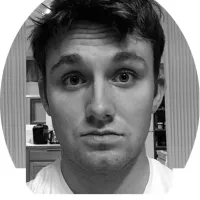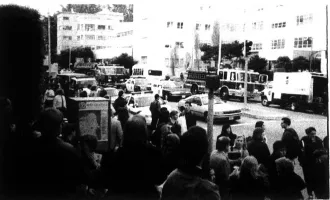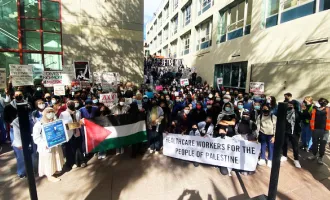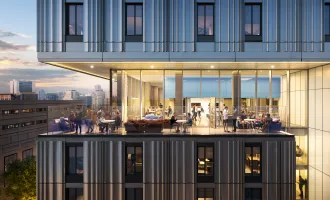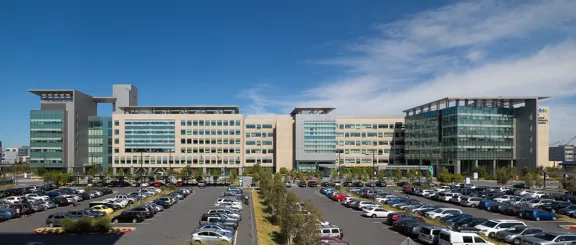
UCSF Chancellor Sued Over Warriors Arena
The mother of a critically ill child is afraid that plans to build a Warriors arena next to the UCSF Medical Center at Mission Bay will put her son's life in danger. Jennifer Wade, the mother of a six-year old boy with a congenital heart defect, is one of the community representatives backing a group called the Mission Bay Alliance (MBA). Together they are suing UCSF Chancellor Sam Hawgood.
The lawsuit claims that emergency access to the UCSF Children’s hospital at Mission Bay, critically important to Wade and her son, would be severely limited by stadium traffic. Furthermore, they claim that Hawgood did not have the authority to sign a Memorandum of Understanding (MOU) on behalf of UCSF in support of the project. They say the MOU strips UCSF of its ability to protect emergency access to its hospitals.
Legal action started with a letter sent to Hawgood on December 2, 2015. The letterhead was that of Boies, Schiller and Flexner LLP, a heavy-hitting New York law firm known for representing Al Gore in Bush vs. Gore and the United States Department of Justice in the landmark antitrust case United States vs. Microsoft.
The letter, acerbic and at times sarcastic, accused Hawgood of illegally entering into the MOU with the Golden State Warriors, who have purchased 11 acres just across 3rd St. from UCSF’s Mission Bay campus. The Warriors intend to build a basketball arena entirely funded by private money and play there by 2017.
A new arena would presumably be a moneymaker for both the team and the city. San Francisco Mayor Ed Lee is a strong supporter of moving the team to Mission Bay. So is former mayor Art Agnos, who previously opposed a proposed arena in the South Beach neighborhood, the plans for which were ultimately abandoned.
In the words of Adam Van de Water, the city and county project manger for the new arena, “the Warriors are an economic engine.”
According to UCSF Vice Chancellor Barbara French, “An arena and events center will bring much needed economic diversity to Mission Bay.” Indeed, the new stadium may bring commercial livelihood to a neighborhood that currently houses UCSF, luxury condos, and not much else.
Yet the MBA, who hired that New York law firm to send the letter, says the move would be a “disaster” and vows to fight it by whatever legal means necessary. Following on the letter, the MBA filed a lawsuit against UCSF on December 21 in Alameda County Superior Court.
The MBA is “a coalition of UCSF stakeholders, faculty, neighbors, and nurses who oppose the proposed Warriors arena in Mission Bay,” according to MBA spokesperson Alex Doniach.
Their fears revolve primarily around hospital access — that traffic congestion caused by the arena, and especially by overlapping events between the arena and AT&T Park, will be so bad that emergency vehicles will be blocked from getting patients to the UCSF hospitals in a timely manner.
The MBA believes that the institution of UCSF is not doing enough to protect its own hospitals. In fact, UCSF is officially on board for the new arena.
The MOU at the center of the lawsuit was signed on October 7, 2015, and commits UCSF to “actively and publicly support” the arena. More importantly, UCSF waived its ability to legally challenge the project. In return, UCSF acquired a legal agreement from the Warriors to reduce events if traffic does turn out to be life-threatening for patients. P.J. Johnston, spokesperson for the Warriors, describes UCSF’s support of the arena as “full and unqualified.”
The Warriors dispute the extent to which the MBA represents UCSF. Johnston doesn’t appear to acknowledge the MBA’s legitimacy.
“All we know is what they’ve said – most of which has turned out to be false,” said Johnston. “They said they represented UCSF; turns out they don’t. UCSF supports the project, and now the MBA super-PAC is threatening to sue UCSF.”
The MBA does not disclose the number of their members that are employed by UCSF, as “the Mission Bay Alliance is not a membership organization…we don’t have a roster of members,” according to spokesperson Doniach.
Nevertheless, Johnston’s interpretation of UCSF’s support (and what a super-PAC is) isn’t exactly subtle.
Yes, UCSF has institutionally pledged support. What is not acknowledged is that UCSF is a community of heterogeneous people, and many prominent leaders in this community have serious concerns about the Warriors moving in next door.
Last September, 20 current and former UCSF professors, including Nobel Laureate Elizabeth Blackburn and the Calico-poached Cynthia Kenyon, authored a letter to Mayor Ed Lee encouraging him to “reconsider the wisdom of proceeding with current construction plans.”
The letter detailed their concerns about the congestion that the arena may cause, “threatening the entire future of UCSF as the center of a world-class academic/biotech/medical complex.”
Basically, this neighborhood ain’t big enough for the two of us.
Due to the presence of UCSF and a number of biotech companies, Mission Bay is one of the most prominent hubs for biotech and life sciences in the entire country. Doniach describes Mission Bay as a UCSF-sponsored bildungsroman: “that swampland has now become a growing and vibrant ecosystem for healthcare, life sciences, and biotech.”
Meanwhile, the Warriors are currently the most dominant team in American professional sports and an endearing one to boot. Having them in San Francisco ought to be a boon for San Francisco, and Mission Bay is one of the few places in this crowded city where there is room for a stadium. Furthermore, the neighborhood is already serviced by MUNI and Caltrain.
UCSF and the Warriors are superstars indeed. But can they cooperate with the fluidity of Steph and Klay, or will their proximity be more like the final years of Kobe and Shaq on the Lakers? (Hopefully neither will call the other “fat and out of shape”)
There seems to be no question that the arena would create a lot of congestion. Can you think of an arena that doesn’t? Johnston’s assertion that “the Warriors intend to be great neighbors” is nice, but sort of empty. On some days, the traffic will probably be annoying for the people that have to commute to and from UCSF.
But annoying is just annoying. The downstairs neighbors that pound on their ceiling every time you get up to walk to the bathroom are annoying, but they don’t exactly threaten your existence — at least they shouldn’t.
But hospital access is a more serious concern for UCSF. The MOU followed nearly a year of discussions between UCSF, the Warriors, and the city.
Vice Chancellor French described the importance of hospital access during these discussions, saying UCSF’s primary goal was “to ensure that patients, healthcare workers, patient visitors and emergency vehicles had timely and safe access to our Mission Bay hospitals.”
What is less clear is the extent to which the Warriors and the city have addressed this concern.
The UCSF institutional line is that the MOU signed on October 7 did allay their concerns. In an email to the UCSF community, Hawgood addressed this off the bat: “Today UCSF finalized agreements with San Francisco Mayor Ed Lee and the Golden State Warriors that would protect patient safety at the UCSF Medical Center at Mission Bay...”
According to project manager Van de Water, “the Chancellor and his campus planning team drove a hard bargain throughout our discussions and secured a number of enforceable and unprecedented transportation mitigations.”
Van de Water and French both refer specifically to local hospital access plans that “preserve certain paths of travel for dedicated hospital and local use,” in the words of Van de Water. They also both point out that the MOU is unique, the first ever agreement between an NBA team and an outside party that can potentially restrict the team’s events.
Still, the Mission Bay Alliance insists that the protections agreed upon in the MOU are barely protective at all. What the language does is potentially limit the number of dual events between the Warriors arena and AT&T Park. If two out of three, or four out of six, of these dual events cause an “unacceptable traffic condition,” then the number of dual events is limited to 12 per year.
In almost every facet this is weak. The 12-game limit, which is not low, goes into place only after a number of “unacceptable traffic conditions” have occurred, a term which seems loosely interpretable already. Furthermore, dual events are defined as only those that overlap with Giants home games, excluding concerts and playoff games.
The MBA would prefer a strategy that is less reactive and more proactive. As Doniach says, “we think that not even one life is worth the risk.” It may be impossible to predict whether events at these nearby stadiums will impede hospital access, but if they do, UCSF may not have enough power to change the situation, having waived “any and all rights in law or equity to challenge the Project,” according to the MOU.
Furthermore, the Warriors have thus far displayed a blasé attitude towards the issue of hospital access. Team owner Joe Lacob has attempted to abate concern by stating that 17 NBA arenas nationwide are within a half mile of hospitals. This seems to be an arbitrary radius that distracts from the actual proximity of the stadium: kitty corner from the UCSF Medical Center. It also does not take into account the already restricted number of thoroughfares that connect Mission Bay to the rest of the city.
“The Warriors arena will not block access to the hospital,” Johnston said quite simply.
He refers to transit- and emergency-only lanes that currently exist 3rd St. and 16th St. As any employee at UCSF Mission Bay knows, there is no transit/emergency-only lane on 16th St., although SFMTA purports to implement one eventually. Also consider that emergency-only lanes would not be available to people driving their own vehicles to the ER, at least without the risk of getting pulled over and ticketed.
Johnston brazenly tried to spin the stadium as a positive for emergency access: “In fact, access for emergency vehicles will actually be better during events at the arena, as there will be a large number of traffic control officers managing traffic that would not otherwise be there.”
In answer to why Chancellor Hawgood might have acquiesced to what the MBA perceives as weak legal protections, the MBA points to Mayor Lee’s involvement in the negotiations and to a letter Lee sent to UCSF in response to UCSF’s concerns about traffic congestion and hospital access.
“The mayor basically threatens to take away various tax exemptions that benefit UCSF,” said Doniach.
The letter itself is not explicitly threatening, but does allude to tax exemptions.
Lee states in the letter that “the nearly 4,000,000 new gsf2 in UCSF-Mission Bay are exempt from paying local property taxes, parking taxes or transportation impact fees even though it will generate 125% of the daily person trips of the Event Center on a non-event day and 58% of daily person trips on a peak event day. My staff will be in touch shortly to re-schedule this follow-up meeting.”
When asked about the tax exemptions mentioned in this letter, Van de Water was initially vague and somewhat evasive: “The University has been investing tremendously in the neighborhood and has really transformed Mission Bay and we were coming at it as strategic partners to make sure that their needs as well as the needs of the neighborhood were met into the future.”
When pressed about the exemptions, Van de Water noted that “UCSF doesn’t contribute the same as a private entity towards transportation” and informed me that the local tax exemptions offered to state institutions have come under legal fire recently: “there have been a number of efforts statewide and in the City and County of San Francisco to enforce collection of locally passed impasse fees and tax measures on state agencies.” He noted that in some jurisdictions these disagreements have led to litigation.
Van de Water said the purpose of the language in that letter was to “discuss fair share contributions.” Still, it seems clear that Chancellor Hawgood may have had reason to believe that the tax exemptions could be challenged, and clearly they were relevant enough to the negotiation process for the Mayor to include in his letter.
The MBA sees its legal action as representing the true voice of the UCSF community in the face of Hawgood’s signature on the MOU.
“Perhaps the chancellor couldn’t oppose this as aggressively as the UCSF community would want,” said Doniach.
The lawsuit will not be able to stop construction of the stadium, but by striking down the MOU, and its waiver concerning UCSF’s legal challenges, it may be able to offer UCSF more legal power if traffic congestion becomes life threatening. Conversely, knocking down the MOU could disrupt the few legal protections that UCSF already has.
Authority to sign the MOU is vested only in the UC Regents, not Hawgood, the lawsuit argues. Furthermore, they claim that signing away a view easement over the arena property constitutes an illegal “gift of public funds.”
If the stadium does not create life-threatening congestion, it may in fact be very positive for Mission Bay and San Francisco as a whole.
Johnston correctly points out that Mission Bay “lacks any real nightlife and is crying out for new amenities, like restaurants, cafés, shops, and other small businesses.” He also says that the arena will “generate $25 million for affordable housing in Mission Bay,” which would truly be great for a neighborhood shadowed by luxury high-rises in a city with a massive affordable housing crisis.
Throughout all this, the UCSF community appears split: some for, some against, and many ambivalent.
